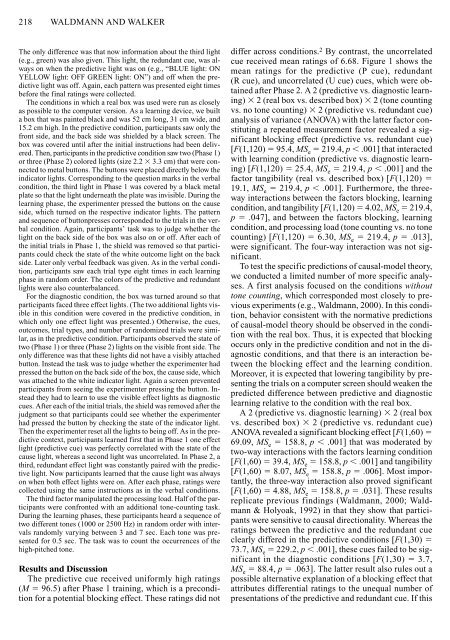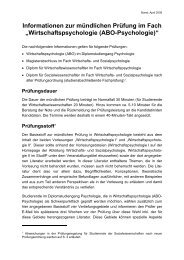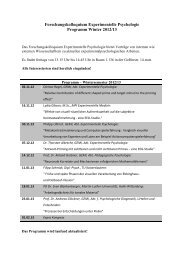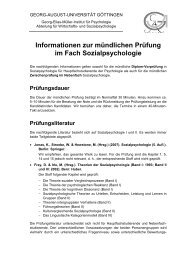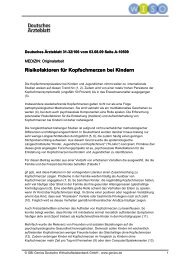Competence and performance in causal learning
Competence and performance in causal learning
Competence and performance in causal learning
You also want an ePaper? Increase the reach of your titles
YUMPU automatically turns print PDFs into web optimized ePapers that Google loves.
218 WALDMANN AND WALKER<br />
The only difference was that now <strong>in</strong>formation about the third light<br />
(e.g., green) was also given. This light, the redundant cue, was always<br />
on when the predictive light was on (e.g., “BLUE light: ON<br />
YELLOW light: OFF GREEN light: ON”) <strong>and</strong> off when the predictive<br />
light was off. Aga<strong>in</strong>, each pattern was presented eight times<br />
before the f<strong>in</strong>al rat<strong>in</strong>gs were collected.<br />
The conditions <strong>in</strong> which a real box was used were run as closely<br />
as possible to the computer version. As a learn<strong>in</strong>g device, we built<br />
a box that was pa<strong>in</strong>ted black <strong>and</strong> was 52 cm long, 31 cm wide, <strong>and</strong><br />
15.2 cm high. In the predictive condition, participants saw only the<br />
front side, <strong>and</strong> the back side was shielded by a black screen. The<br />
box was covered until after the <strong>in</strong>itial <strong>in</strong>structions had been delivered.<br />
Then, participants <strong>in</strong> the predictive condition saw two (Phase 1)<br />
or three (Phase 2) colored lights (size 2.2 3.3 cm) that were connected<br />
to metal buttons. The buttons were placed directly below the<br />
<strong>in</strong>dicator lights. Correspond<strong>in</strong>g to the question marks <strong>in</strong> the verbal<br />
condition, the third light <strong>in</strong> Phase 1 was covered by a black metal<br />
plate so that the light underneath the plate was <strong>in</strong>visible. Dur<strong>in</strong>g the<br />
learn<strong>in</strong>g phase, the experimenter pressed the buttons on the cause<br />
side, which turned on the respective <strong>in</strong>dicator lights. The pattern<br />
<strong>and</strong> sequence of buttonpresses corresponded to the trials <strong>in</strong> the verbal<br />
condition. Aga<strong>in</strong>, participants’ task was to judge whether the<br />
light on the back side of the box was also on or off. After each of<br />
the <strong>in</strong>itial trials <strong>in</strong> Phase 1, the shield was removed so that participants<br />
could check the state of the white outcome light on the back<br />
side. Later only verbal feedback was given. As <strong>in</strong> the verbal condition,<br />
participants saw each trial type eight times <strong>in</strong> each learn<strong>in</strong>g<br />
phase <strong>in</strong> r<strong>and</strong>om order. The colors of the predictive <strong>and</strong> redundant<br />
lights were also counterbalanced.<br />
For the diagnostic condition, the box was turned around so that<br />
participants faced three effect lights. (The two additional lights visible<br />
<strong>in</strong> this condition were covered <strong>in</strong> the predictive condition, <strong>in</strong><br />
which only one effect light was presented.) Otherwise, the cues,<br />
outcomes, trial types, <strong>and</strong> number of r<strong>and</strong>omized trials were similar,<br />
as <strong>in</strong> the predictive condition. Participants observed the state of<br />
two (Phase 1) or three (Phase 2) lights on the visible front side. The<br />
only difference was that these lights did not have a visibly attached<br />
button. Instead the task was to judge whether the experimenter had<br />
pressed the button on the back side of the box, the cause side, which<br />
was attached to the white <strong>in</strong>dicator light. Aga<strong>in</strong> a screen prevented<br />
participants from see<strong>in</strong>g the experimenter press<strong>in</strong>g the button. Instead<br />
they had to learn to use the visible effect lights as diagnostic<br />
cues. After each of the <strong>in</strong>itial trials, the shield was removed after the<br />
judgment so that participants could see whether the experimenter<br />
had pressed the button by check<strong>in</strong>g the state of the <strong>in</strong>dicator light.<br />
Then the experimenter reset all the lights to be<strong>in</strong>g off. As <strong>in</strong> the predictive<br />
context, participants learned first that <strong>in</strong> Phase 1 one effect<br />
light (predictive cue) was perfectly correlated with the state of the<br />
cause light, whereas a second light was uncorrelated. In Phase 2, a<br />
third, redundant effect light was constantly paired with the predictive<br />
light. Now participants learned that the cause light was always<br />
on when both effect lights were on. After each phase, rat<strong>in</strong>gs were<br />
collected us<strong>in</strong>g the same <strong>in</strong>structions as <strong>in</strong> the verbal conditions.<br />
The third factor manipulated the process<strong>in</strong>g load. Half of the participants<br />
were confronted with an additional tone-count<strong>in</strong>g task.<br />
Dur<strong>in</strong>g the learn<strong>in</strong>g phases, these participants heard a sequence of<br />
two different tones (1000 or 2500 Hz) <strong>in</strong> r<strong>and</strong>om order with <strong>in</strong>tervals<br />
r<strong>and</strong>omly vary<strong>in</strong>g between 3 <strong>and</strong> 7 sec. Each tone was presented<br />
for 0.5 sec. The task was to count the occurrences of the<br />
high-pitched tone.<br />
Results <strong>and</strong> Discussion<br />
The predictive cue received uniformly high rat<strong>in</strong>gs<br />
(M 96.5) after Phase 1 tra<strong>in</strong><strong>in</strong>g, which is a precondition<br />
for a potential block<strong>in</strong>g effect. These rat<strong>in</strong>gs did not<br />
differ across conditions. 2 By contrast, the uncorrelated<br />
cue received mean rat<strong>in</strong>gs of 6.68. Figure 1 shows the<br />
mean rat<strong>in</strong>gs for the predictive (P cue), redundant<br />
(R cue), <strong>and</strong> uncorrelated (U cue) cues, which were obta<strong>in</strong>ed<br />
after Phase 2. A 2 (predictive vs. diagnostic learn<strong>in</strong>g)<br />
2 (real box vs. described box) 2 (tone count<strong>in</strong>g<br />
vs. no tone count<strong>in</strong>g) 2 (predictive vs. redundant cue)<br />
analysis of variance (ANOVA) with the latter factor constitut<strong>in</strong>g<br />
a repeated measurement factor revealed a significant<br />
block<strong>in</strong>g effect (predictive vs. redundant cue)<br />
[F(1,120) 95.4, MS e 219.4, p .001] that <strong>in</strong>teracted<br />
with learn<strong>in</strong>g condition (predictive vs. diagnostic learn<strong>in</strong>g)<br />
[F(1,120) 25.4, MS e 219.4, p .001] <strong>and</strong> the<br />
factor tangibility (real vs. described box) [F(1,120) <br />
19.1, MS e 219.4, p .001]. Furthermore, the threeway<br />
<strong>in</strong>teractions between the factors block<strong>in</strong>g, learn<strong>in</strong>g<br />
condition, <strong>and</strong> tangibility [F(1,120) 4.02, MS e 219.4,<br />
p .047], <strong>and</strong> between the factors block<strong>in</strong>g, learn<strong>in</strong>g<br />
condition, <strong>and</strong> process<strong>in</strong>g load (tone count<strong>in</strong>g vs. no tone<br />
count<strong>in</strong>g) [F(1,120) 6.30, MS e 219.4, p .013],<br />
were significant. The four-way <strong>in</strong>teraction was not significant.<br />
To test the specific predictions of <strong>causal</strong>-model theory,<br />
we conducted a limited number of more specific analyses.<br />
A first analysis focused on the conditions without<br />
tone count<strong>in</strong>g, which corresponded most closely to previous<br />
experiments (e.g., Waldmann, 2000). In this condition,<br />
behavior consistent with the normative predictions<br />
of <strong>causal</strong>-model theory should be observed <strong>in</strong> the condition<br />
with the real box. Thus, it is expected that block<strong>in</strong>g<br />
occurs only <strong>in</strong> the predictive condition <strong>and</strong> not <strong>in</strong> the diagnostic<br />
conditions, <strong>and</strong> that there is an <strong>in</strong>teraction between<br />
the block<strong>in</strong>g effect <strong>and</strong> the learn<strong>in</strong>g condition.<br />
Moreover, it is expected that lower<strong>in</strong>g tangibility by present<strong>in</strong>g<br />
the trials on a computer screen should weaken the<br />
predicted difference between predictive <strong>and</strong> diagnostic<br />
learn<strong>in</strong>g relative to the condition with the real box.<br />
A 2 (predictive vs. diagnostic learn<strong>in</strong>g) 2 (real box<br />
vs. described box) 2 (predictive vs. redundant cue)<br />
ANOVA revealed a significant block<strong>in</strong>g effect [F(1,60) <br />
69.09, MS e 158.8, p .001] that was moderated by<br />
two-way <strong>in</strong>teractions with the factors learn<strong>in</strong>g condition<br />
[F(1,60) 39.4, MS e 158.8, p .001] <strong>and</strong> tangibility<br />
[F(1,60) 8.07, MS e 158.8, p .006]. Most importantly,<br />
the three-way <strong>in</strong>teraction also proved significant<br />
[F(1,60) 4.88, MS e 158.8, p .031]. These results<br />
replicate previous f<strong>in</strong>d<strong>in</strong>gs (Waldmann, 2000; Waldmann<br />
& Holyoak, 1992) <strong>in</strong> that they show that participants<br />
were sensitive to <strong>causal</strong> directionality. Whereas the<br />
rat<strong>in</strong>gs between the predictive <strong>and</strong> the redundant cue<br />
clearly differed <strong>in</strong> the predictive conditions [F(1,30) <br />
73.7, MS e 229.2, p .001], these cues failed to be significant<br />
<strong>in</strong> the diagnostic conditions [F(1,30) 3.7,<br />
MS e 88.4, p .063]. The latter result also rules out a<br />
possible alternative explanation of a block<strong>in</strong>g effect that<br />
attributes differential rat<strong>in</strong>gs to the unequal number of<br />
presentations of the predictive <strong>and</strong> redundant cue. If this


